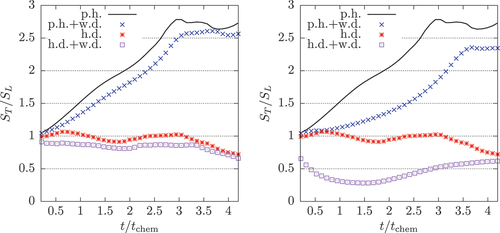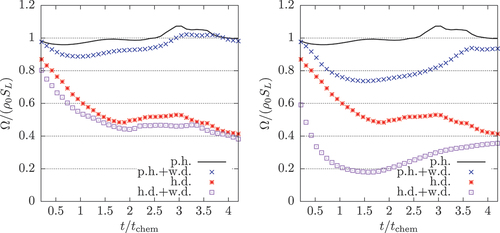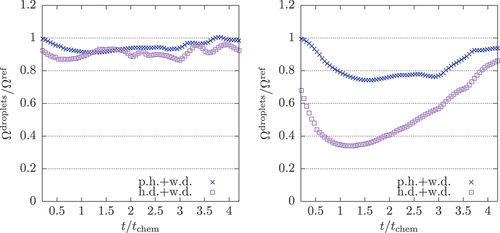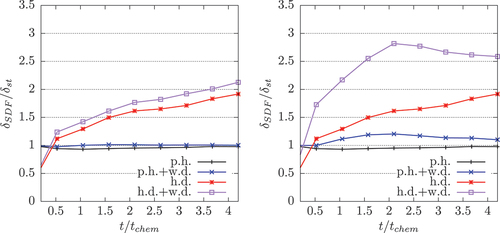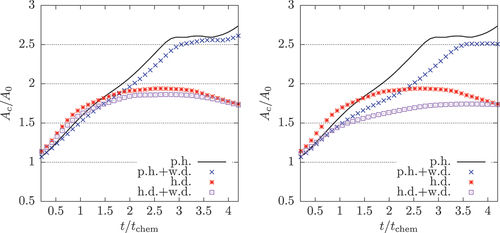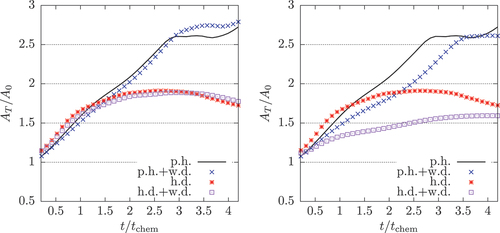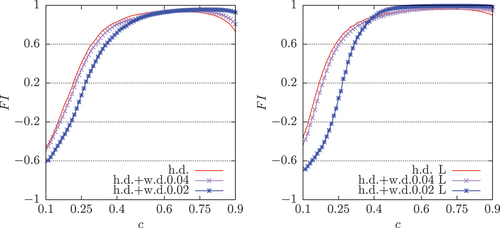 ?Mathematical formulae have been encoded as MathML and are displayed in this HTML version using MathJax in order to improve their display. Uncheck the box to turn MathJax off. This feature requires Javascript. Click on a formula to zoom.
?Mathematical formulae have been encoded as MathML and are displayed in this HTML version using MathJax in order to improve their display. Uncheck the box to turn MathJax off. This feature requires Javascript. Click on a formula to zoom.ABSTRACT
Carrier-phase direct numerical simulations (DNS) of n-heptane/air combustion with water droplet injection are reported in this paper. The influence of water droplet injection has been analyzed for statistically planar gaseous premixed flames and spray flames where the fuel is supplied in the form of monodisperse fuel droplets. The effects of water injection in both types of flames are compared, including their sensitivities on the initial diameter of water droplets. The simulations are based on an Eulerian-Lagrangian-Lagrangian approach to consider the multi-phase interaction and the simultaneous effects of n-heptane and water droplets. It is shown that the two types of flames are different in terms of several aspects. In particular, the spray flames are characterized by lower temperatures, and their propagation speed is lower than for premixed flames. The main reason for these differences lies in the gaseous equivalence ratio experienced by the reaction zone. For the cases investigated here, where the overall equivalence ratio is unity, the spray combustion occurs under predominantly fuel-lean conditions. Furthermore, the flame temperature is influenced by the initial diameter of water droplets, which affects the strength of thermal expansion within the flame. This in turn influences the evaporation characteristics of both fuel and water droplets due to different residence times within the flame. Although the effects of water droplets on the combustion mode are dependent on the relative position within the spray flame, the net effect is a partial shift from non-premixed to premixed mode. At the same time, the spray combustion occurs under relatively fuel-richer conditions with water injection and these trends appear consistently in laminar and turbulent flows.
Introduction
Nowadays, increasingly stringent rules about pollutant emissions from propulsion and power generation processes create a new challenge and the necessity to implement new techniques to respect these newly imposed limits. In that sense, the direct water injection represents a suitable technique that aids in reducing the and other pollutants that arise from hydrocarbon/air combustion (Kotob, Lu, and Wahid Citation2020; Shahpouri and Houshfar Citation2019; Sun et al. Citation2022). This technique aims to decrease the maximum combustion temperature, which is the main reason for
formation. The injection of water inside internal combustion engines was already applied to improve power output for a limited amount of time in internal combustion engines due to increased mass flow rate. Several experimental studies were performed to analyze both the effects on pollutant emissions and performance of Diesel engines with water injection (Arabaci et al. Citation2015; Mingrui et al. Citation2017; Tesfa et al. Citation2012). It was shown that the decrease of peak temperature leads to reasonable control of
emissions. In contrast, the effect on other pollutant emissions depends on the engine’s operating point regarding the power and fuel efficiency. The increase of power output and fuel efficiency due to water injection was demonstrated also for gas turbine combustors by Lellek (Citation2017).
This study focuses on the different physical effects (cooling and dilution) of liquid water injection on conventional premixed combustion as well as spray combustion where fuel is supplied in the form of liquid droplets, considering also the influence of the initial diameter of water droplets. It is already known from previous numerical and experimental analyses (Hayashi, Kumagai, and Sakai Citation1977; Nicoli, Denet, and Haldenwang Citation2014; Nicoli, Haldenwang, and Denet Citation2016) that purely gaseous and multi-phase flames show velocity differences also for identical overall equivalence ratio , where
is the liquid equivalence ratio and
is the gaseous equivalence ratio. The differences are due to multiple phenomena in the two types of flame that lead to different structures. While the premixed gaseous flame is a well-known configuration, the spray flames simultaneously exhibit both premixed and non-premixed combustion modes and the presence of other phenomena like fuel-supplying through liquid phase evaporation that generates locally non-homogeneous conditions. In the previous work of Reveillon and Vervisch (Citation2005), it was demonstrated that spray combustion can exhibit different regimes depending on three nondimensional parameters related to the overall equivalence ratio, mean inter-droplet distance and the ratio between flame and evaporation timescales. However, the flame propagation behavior differs in these regimes due to the differences in gaseous equivalence ratio. This quantity is determined from several parameters, like the initial droplet diameter, the residence time or the initial liquid equivalence ratio, as numerically demonstrated by Neophytou and Mastorakos Citation2009) through the simulation of laminar one-dimensional flames in fuel droplet mist. It is demonstrated that in some cases
in fuel droplet combustion can fall in a range of values that facilitate higher burning velocity than the corresponding premixed flame for identical
. This behavior originates not only because
can get closer to stoichiometric conditions than the overall equivalence ratio but also due to the generation of radicals from hydrocarbon pyrolysis as suggested by Neophytou, Mastorakos, and Cant (Citation2012) through the simulation of igniting flames with a reduced chemical mechanism. The gaseous equivalence ratio affects not only local consumption rate of reactants but also the flame surface area and their combined effects are reflected in the overall burning rate as demonstrated by Ozel-Erol et al. (Citation2019) who analyzed the evolution of spherically expanding flames propagating into fuel mists at different overall equivalence ratios and initial droplet diameters. It was also shown in previous studies (Hayashi, Kumagai, and Sakai Citation1977; Nicoli, Haldenwang, and Denet Citation2019) that the disturbances induced by fuel droplets on the flame surface can trigger the Darrieus-Landau instability, hence increasing the flame wrinkling and overall burning rate in this way. Such effects of droplet-flame interaction are not observed in the present study because the parameters considered here are out of the range in which these phenomena are dominant.
Water evaporation has three main effects on the combustion process: dilution of reactants, latent heat extraction and density increase in the system. In this work, effects related to chemical kinetics (such as the comparably high third-body efficiency of water vapor) are not taken into account because they are considered higher order effects compared to the physical effects. The thermal effects of water injection make it suitable for different applications related to internal combustion engines and power generation but also related to plant safety and fire suppression. Thomas, Jones, and Edwards (Citation1991) experimentally demonstrated the effectiveness of liquid water for explosion suppression, showing that flame quenching is not only due to the heat sink effect but also due to the increase in energy and mass transfer caused by droplet breakup. In recent years, Zhang et al. (Citation2014) tested the ability of water micro-particles to decrease the pressure buildup in closed vessel explosions at different fuel to air ratios. However, if designed inappropriately, the water injection can also enhance flame propagation due to the triggering of fluid-dynamic instability. Nicoli, Haldenwang, and Denet (Citation2019) numerically showed that the burning velocity is not necessarily attenuated in the presence of water mist. Arias et al. (Citation2011) extrapolated a criterion to predict if quenching in diffusion flames occurs due to the simultaneous effects of stretching and water dilution.
Several experimental studies on multi-phase combustion with water injection are present in the literature (Merola, Irimescu, and Maria Vaglieco Citation2020; Takasaki, Fukuyoshi, and Abe Citation1998). Since experiments are often limited to a global characterization of combustion systems, DNS is of paramount importance to reach a better understanding of the local processes underlying droplet-flame interaction. To the best of the authors’ knowledge, numerical studies that analyze the simultaneous injection of two liquid substances with different thermo-physical properties (cf. ) in the combustion context are currently not available in the literature.
Table 1. Thermo-physical properties of liquid n-heptane and water.
For this purpose, a two-way coupled Eulerian-Lagrangian-Lagrangian approach is adopted to analyze the effects of simultaneous interaction of water and fuel droplets with the flame. The comparison between premixed combustion and spray combustion with water injection is at the focus of this paper.
The manuscript is organized as follows. The section introduces the mathematical model and its implementation is described in the
section. The
section discusses the results and in the
section, the conclusions are finally presented.
Mathematical background
Although it is possible to perform three-dimensional DNS with detailed chemical mechanisms (Chen et al. Citation2009; Klein et al. Citation2020), this results in high computational costs, making it unattractive for extensive parametric studies. Furthermore, it has been shown that flame propagation statistics from simple chemistry DNS are in good agreement with detailed chemistry and transport data (Keil et al. Citation2021). For this reason, a modified single-step irreversible Arrhenius chemical reaction is used to model the chemistry, with the following general formulation:
From equation 1, the fuel reaction rate is computed by an Arrhenius-type expression:
where is the gas density,
is the normalized pre-exponential factor,
and
are fuel and oxygen mass fraction,
is the Zel’dovich number,
is a heat release related parameter
,
is the normalized temperature, where
is the dimensional temperature,
is the adiabatic flame temperature of the stoichiometric mixture, and
is the unburned gas temperature. In this work, the unburned temperature
is taken as
, which yields a heat release factor of
for stoichiometric n-heptane/air combustion. The heat of combustion, the Zel’dovich number and the activation energy are taken as functions of the local equivalence ratio as proposed by Fernández-Tarrazo et al. (Citation2006). This model was validated in previous work (Hasslberger et al. Citation2021), showing that the model captures well the laminar burning velocity trend as a function of the steam concentration. More advanced chemical models, considering a higher number of species and elementary reactions than the modified single-step model adopted here, are not always able to capture the correct burning velocity variation with equivalence ratio. The available skeletal models for n-heptane that have this ability are based on 110 species and 1170 reactions (Zeuch et al. Citation2008), for example. Other computationally bearable reduced models, e.g. based on a two-step chemistry (Bibrzycki and Poinsot Citation2010; Turquand d'Auzay et al. Citation2019), do not show any advantage compared to the current one since they require a similar degree of tuning to reproduce the qualitative trends of the burning velocity.
Inspired by the previous work of Reveillon and Vervisch (Citation2005), a two-way coupled Eulerian-Lagrangian-Lagrangian approach is used. The liquid phase is treated by a Lagrangian approach, in which the individual droplets of water and n-heptane are tracked along their trajectories and considered as point particles. The following equations describe their dynamics:
The variables ,
,
and
are droplet position, velocity, diameter and temperature respectively. Here,
is the latent heat of vaporization and
is the gaseous specific heat at constant pressure. In equation 3, the hypothesis of infinite thermal diffusivity is made, i.e. the droplet temperature is assumed as uniform. The relaxation times
,
and
in the system of equations are calculated through the following formulas:
where the timescales are expressed as functions of droplet density and corrected drag coefficient
that is dependent on droplet Reynolds number
. The timescales also require the Schmidt number
, the Spalding number
and the corrected Nusselt and Sherwood number
. To evaluate the Spalding number, the gaseous species mass fraction at the droplet surface
is necessary (index
represents n-heptane,
, or water,
) and it is calculated from equilibrium conditions via the partial pressure
obtained by the Clausius-Clapeyron equation:
Here, and
are the molar mass of the gaseous phase and liquid phase,
is the reference pressure and
is the boiling temperature at the reference pressure.
The gaseous phase equations can be written in the following general form:
where is
1,
,
,
,
,
and
is
1,
,
,
,
,
for the different conservation equations. The term
is a source term related to chemical reaction, while
is a source or sink term of the conservation equation, like pressure gradients in the momentum equation, and
incorporates the carrier phase-droplet interaction. This last term is computed as
where the values are computed at the droplet position
via tri-linear interpolation from the eight surrounding grid points. The dynamic viscosity is assumed constant and all other diffusivities are derived from the constant Schmidt number and Prandtl number (
). The Lewis number in this simulation is assumed to be unity for all the chemical species considered. The gaseous phase is considered a perfect gas, i.e. the specific heats are constant and their ratio is
.
Numerical implementation
A three-dimensional compressible DNS code, SENGA+ (Jenkins and Cant Citation2002; Schroll et al. Citation2009; Wandel and Mastorakos Citation2009), is used. The spatial discretization is performed by a order central finite difference scheme for internal grid points that degrades to a one-sided
order scheme at non-periodic boundaries. Explicit time advancement is realized by a
order low-storage Runge-Kutta method (Wray Citation1990). The computational domain is the same as in previous spray combustion DNS studies (Hasslberger et al. Citation2021; Malkeson et al. Citation2020; Wacks et al. Citation2016), i.e. a rectangular volume of dimensions
, where
is the thermal thickness of the unstretched laminar premixed stoichiometric n-heptane/air flame:
The domain is discretized by grid points such that more than 10 points are used to resolve
and about 2 points to resolve Kolmogorov’s length scale
. As in the several earlier publications using SENGA+ (Chakraborty et al. Citation2021; Hasslberger et al. Citation2021; Malkeson et al. Citation2020; Wacks et al. Citation2016), both the inner flame structure as well as the turbulence characteristics are accurately captured in this way. It has been found that coarsening the mesh by a factor of 2.0 did not change the values of the unstretched laminar burning velocity of the stoichiometric n-heptane/air mixture
and the thermal flame thickness of the stoichiometric mixture
appreciably (
). The boundary conditions are periodic in transverse directions,
and
, while boundaries are partially non-reflecting in longitudinal direction
, which are via the Navier-Stokes Characteristic Boundary Conditions (NSCBC) technique. The turbulent flow is initialized by an incompressible velocity field that exhibits a Batchelor-Townsend turbulent kinetic energy spectrum (Batchelor and Townsend Citation1948) with intensity
and normalized integral length scale
. The same field is used as an inlet velocity condition to maintain turbulence at the inlet during the simulation. The initial thermo-chemical conditions are taken from one-dimensional laminar simulations carried out through COSILAB using the model by Neophytou and Mastorakos (Citation2009).
In this work, different spray combustion simulations are compared with premixed combustion cases with the same overall equivalence ratio , overall water loading
and varying water droplet initial diameter
(cf. ).
Table 2. Simulation parameters for different cases: fuel droplet initial diameter , water droplet initial diameter
, overall water loading
. The p. means premixed, h. means heptane, d. means droplets and w. means water. These abbreviations are used throughout this work.
The droplets considered here are modeled as point particles because their dimensions with respect to the Kolmogorov length scale are ,
for
,
, respectively. Hence, the initial diameter with respect to grid spacing is
and
. The ratio between initial droplets diameter and grid size is comparable with previous similar analysis (Fujita et al. Citation2013; Neophytou et al. Citation2010; Sreedhara and Huh Citation2007; Wang and Rutland Citation2005). Since the droplet mist is sufficiently diluted, a two-way coupling approach is adopted without considering particle-particle interactions. The particle number density is in the range of
and the average droplet inter-distance is
and
. All simulations are performed for at least 4 chemical time scales
, where
is the gas diffusivity, and this simulation time corresponds to 3 eddy turnover times
. All these parameters are similar to previous spray combustion DNS studies (Ozel-Erol et al. Citation2019; Fujita et al. Citation2013; Hasslberger et al. Citation2021; Pera, Chevillard, and Reveillon Citation2013; Wang and Rutland Citation2005). Showing that the numerical results qualitatively agree with previous experiments (Hayashi, Kumagai, and Sakai Citation1977; Lawes and Saat Citation2011), these previous works also underline the suitability of the current methodology.
The reaction progress variable as used in the following evaluations is computed from the oxygen mass fraction:
where is the mixture fraction defined as
,
is the mixture fraction at stoichiometric conditions and
is the oxygen mass fraction in the pure air stream. The progress variable is identically
for unburned conditions and 1 for burned conditions, while
is 0 in the pure oxidizer stream and 1 in the pure fuel stream. The progress variable allows to take statistics conditional on the location relative to the flame in the following.
Results and discussions
Under the unity Lewis number assumption in single-phase combustion, normalized temperature and progress variable fields are identical to each other for a low Mach number and globally adiabatic condition. An evaporating liquid phase is present in the cases studied here, which extracts latent heat for evaporation. For this reason, the assumption is no longer valid. It can be observed in the first row of , where the case of premixed combustion with water injection is visualized, that the
iso-surface is smooth apart from wrinkles due to turbulence. In contrast, the
iso-surface features small-scale deformations in the proximity of evaporating water droplets. The water evaporation generates local temperature gradients but does not influence the local equivalence ratio and mixture fraction because the mass fractions of reactants are modified by the same factor due to the local steam release, i.e. density change. In spray combustion, the evaporation of fuel droplets affects the local equivalence ratio and thus also local value of the progress variable. In the second row of , both iso-surfaces feature small dimples in the proximity of droplets; in
, these occur only near n-heptane droplets, while in
, the deformations are caused by both droplet types. These observations are in qualitative agreement with the experimental results of Hayashi, Kumagai, and Sakai (Citation1977) and Lawes and Saat (Citation2011) regarding the flame wrinkling induced by fuel droplets.
Figure 1. Iso-surface of progress variable (
column) and temperature
(
column) taken at
and
for premixed combustion (
row) and spray combustion (
row) at
. In all cases, the water droplet size is
. The light blue dots are water droplets, while the red dots indicate n-heptane droplets (not to the scale).
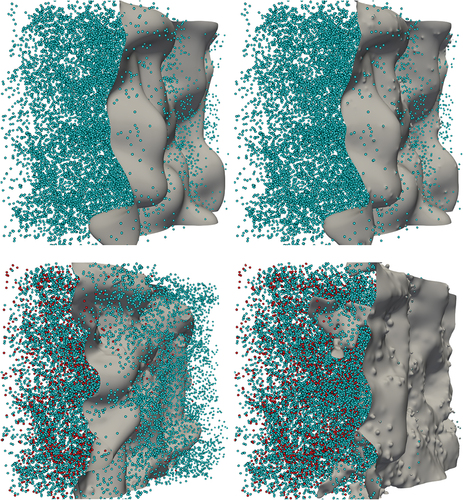
The midplane temperature fields are shown in for all the cases simulated. First, it is important to note that spray combustion without water injection results in a colder flame than for the purely premixed case. The two main reasons for this difference are the heat extraction due to liquid n-heptane vaporization and the difference in the gaseous equivalence ratio
, which locally determines the chemical reaction rate. As mentioned before, all cases considered here feature the same overall equivalence ratio
. In the premixed cases, this is equivalent to stoichiometric combustion conditions, while for spray combustion cases, the gaseous equivalence ratio is predominantly less than unity, i.e. fuel-lean conditions. A crucial consequence of lower flame temperature is the attenuated thermal expansion and lower mean flow velocity on the burned gas side. Hence, the droplets move slower due to lower mean flow velocity, which implies a higher residence time inside the flame.
Figure 2. Temperature field on the
mid-plane, for premixed combustion (left column) and spray combustion (right column) cases without water injection (
row), with
(
row) and
(
row). The white dots are the n-heptane droplets, while the pink dots indicate the water droplets (not to the scale). White iso-contours represent
,
and
, respectively. The results are taken at
.
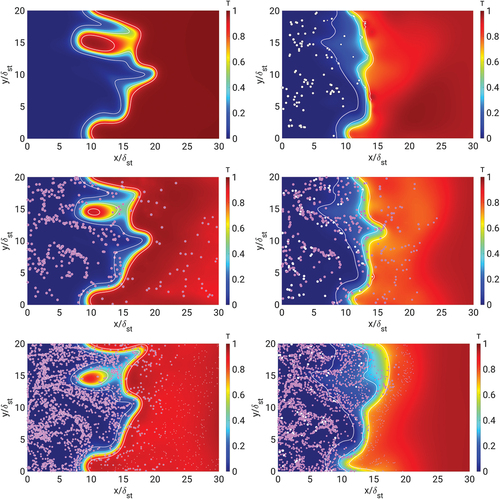
One important effect of liquid water injection is the extraction of latent heat due to droplet evaporation, which is enhanced with small water droplets because the evaporation rate is strongly dependent on the droplet size. The water has a much higher latent heat of vaporization than n-heptane, as can be seen in . For this reason, the n-heptane droplets rarely pass through the flame while water droplets persist also in the burned gas region. It may also be observed that the cooling effect on temperature is more homogeneous with a higher number of smaller water droplets than with a lower number of larger water droplets. Smaller droplets evaporate faster and the mean droplet inter-distance is also smaller at identical overall water loading .
In , it is evident that in the spray combustion cases the steam concentration is higher than in the premixed cases. These effects are related to the flame temperature and thermal expansion as mentioned before. Note that the water vapor concentration considered here is only due to liquid water evaporation, it excludes the water produced by the chemical reaction.
Figure 3. Water vapour fields on the
mid-plane, for premixed combustion (
column) and spray combustion (
column) cases with
(
row) and
(
row). The white dots are the n-heptane droplets, while the pink dots indicate the water droplets (not to the scale). White iso-contours represent
,
and
, respectively. The results are taken at
.

When the flame temperature decreases and the reactants are diluted, flame thickening occurs, as can be observed when comparing the two types of flames in . The thicker the flame, the higher the droplet residence time within the flame, which implies more evaporation and more homogenization by diffusion. As a consequence, the flame burns under fuel-richer conditions and under a relatively increased premixed combustion mode, as will be elaborated later.
The higher water vapor concentrations inside the flame for spray combustion cases in comparison to premixed combustion cases are quantified in . These quantitative results agree with what can be observed qualitatively from the slices. It is also evident that the steam concentration inside the flame is more than two times higher with the smaller water droplets than with the larger water droplets which is consistent with the evaporation law depending quadratically on the droplet size. In the spray combustion case with the smaller water droplets, the peak value of the gaseous water concentration is close to the overall water loading of
.
Figure 4. Time evolution of water vapour concentration within the flame (
) for the cases with water injection. Water droplet size
(left side) and
(right side).
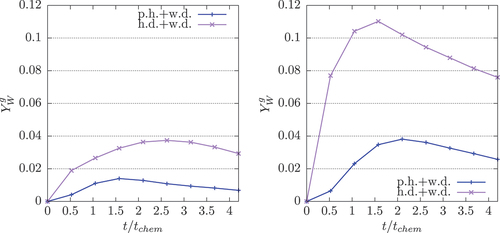
reports the turbulent burning velocity, defined by
for the different cases with and without water injection. It can be seen from that the behavior of in the two types of flames is largely different because
in the premixed cases shows an increasing trend before reaching a quasi-steady state, while the spray combustion cases maintain more or less constant values of
. It is also clear that the water addition affects the burning velocity significantly. Already with the larger water droplets, the turbulent burning velocity with water injection is lower than in the reference cases without water. With smaller droplets, the deficit in burning velocity becomes even stronger. The water addition effects on burning velocity are mainly due to the cooling effect which directly influences the chemical reaction rate. The turbulent burning velocity is strongly related to the flame area, as can be seen from the comparison of which are showing similar general trends. Hence, it is interesting to decouple the flame area effects from the burning velocity by examining the burning rate per unit area
:
For a purely premixed case at moderate turbulence intensities, the value of is close to unity as postulated by Damköhler’s first hypothesis, thus the deviation from this value indicates the departure from the purely premixed case (Hasslberger et al. Citation2021). Consistent with earlier observations, the spray combustion cases show a different trend to premixed combustion in . The water injection lowers the burning rate per unit area. However, in the larger water droplet cases, this effect remains marginal, while it becomes significant with smaller droplets.
From , it is possible to conclude that the nature of the fuel supply to the flame (i.e. entirely in gaseous phase for the premixed flame or in the form of droplets in the spray flame) is responsible for the main difference between the cases. Nevertheless, to isolate the effects of water injection and to evaluate the different sensitivity to initial droplet diameter, it is instructive to measure the relative changes with respect to the reference value without water injection for the corresponding flame. In , the trends of the relative burning velocity per unit area
are reported.
Apparently, the relative burning velocity follows a similar trend for both premixed and spray combustion in the case with large water droplets. This means that the differences on the left side of are mostly related to the nature of the fuel supply to the flame (i.e. entirely in gaseous phase or in the form of droplets) and not due to the different responses to water injection. However, a different behavior can be observed in the case with smaller water droplets, where the spray combustion case shows a higher sensitivity to water injection. This holds true especially in the first part of the simulation, in which decreases to considerably different values of around 0.8 and 0.4, respectively.
The spray combustion cases are characterized by a wider flame thickness than the premixed combustion cases which is associated to the changes in flame temperature. The flame thickness can be defined as
where is the flame surface density function (SDF) and
stands for an average conditional on the progress variable
. Consistent with earlier observations, the effect on flame thickness is more substantial with smaller water droplets as can be seen in . The normalized surface density function is shown in exemplarily for
, where both premixed and spray combustion cases show the expected trends. It can again be observed that the spray combustion case shows a higher sensitivity. In the cases with smaller water droplets, the flame thickness increases by a factor of about 1.5 with respect to the reference case without water injection, whereas it is only a factor of about 1.2 in the case with premixed combustion.
Figure 9. Surface density function conditioned on progress variable
, with
(left side) and
(right side). Statistics are taken at
.
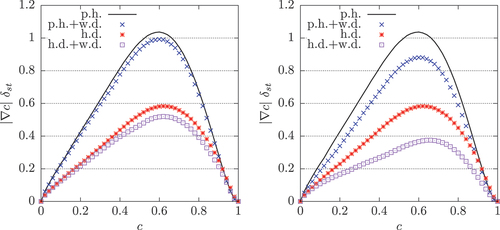
The flame area and turbulent burning velocity are strongly related as already stated. The flame area is computed as
and shown as a function of time in . In the configuration examined, the flame area evolves due to the interaction with turbulence and droplets. Owing to the moderate turbulence intensity investigated, the turbulence has a flame-area enhancing effect due to flame wrinkling. In contrast, the flame-droplet interaction could have an increasing or decreasing effect on the flame area generation depending on the heat extraction and concentration field deformation. As already observed in , the water droplets barely affect the reactant concentration fields. Hence, the dominant consequence on the flame area is related to the (local) flame temperature reduction, i.e. gas density elevation. It is important to mention in this context that flame thickening makes the flame more resistant to wrinkling due to turbulent velocity fluctuations. On the contrary, the n-heptane droplets strongly affect the local mixture fraction and the progress variable field. For this reason, the spray combustion cases have a higher flame area than premixed cases during the initial interaction stage, i.e. until approximately 1.5 chemical time scales. After that, the dampening of flame surface disturbances becomes dominant, resulting in a lower flame area for the spray cases.
Since normalized temperature and progress variable are not coincident in the cases with multi-phase combustion and phase change, it is instructive to calculate also the flame area based on the nondimensional temperature field:
With respect to this quantity, also the water droplets have a noticeable effect on the flame area due to local deformations of the temperature field, as can be noticed in . The temporal evolution of the temperature-based flame area is shown in . The flame area in the final stage of the simulation becomes higher in the cases with water injection than in those without (at least with the larger water droplets). This is a consequence of the water droplets evaporating more slowly, i.e. their effect becomes evident later as compared to n-heptane droplets.
The evaporation rate is stronger for smaller droplets, which induces stronger cooling effects and as a result the turbulence augmentation due to thermal expansion is weaker for smaller droplets (Hasslberger et al. Citation2021). The weaker turbulence intensity within the flame for smaller droplets also give rise to a reduction in flame surface area with decreasing initial water droplet diameter. In spray combustion, this becomes the dominant mechanism, whereas in premixed combustion with water injection, the flame area can become even higher than in the purely premixed case due to droplet-induced wrinkling of temperature iso-surfaces.
In order to explain the effects of water injection on overall burning rate and flame surface area in spray flames, it is useful to look into the mixture composition and the mode of combustion within the reaction zone, which will be analyzed next in this paper. shows probability density functions (PDFs) of gaseous equivalence ratio inside the flame (
) for the spray combustion cases for different initial water diameters. The equivalence ratio distributions inside the spray flames in show richer conditions and a somewhat broader spectrum of local gaseous equivalence ratio values with water injection. The behavior of the
distribution can be explained by the cooling effect of the water on the temperature field, which has a direct influence on the flow velocity field. The latter affects the mixing and residence time of the droplets inside the different regions of the flame. These effects are elaborated in the subsequent analysis.
Figure 12. Probability density function of gaseous equivalence ratio inside the flame (
) for the spray combustion cases at
, with
(left side) and
(right side).
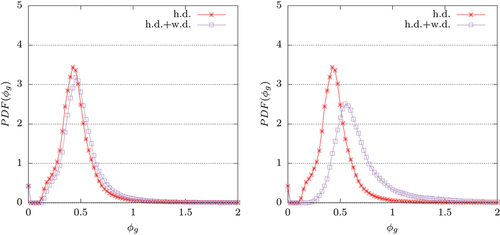
The trend observed in for turbulent cases is confirmed for laminar cases in . In this way, the direct consequences of water injection are isolated from the indirect consequences related to turbulence. As expected, the discrepancy with the case without water injection is less visible for larger water droplets. Although seem to suggest that the mixture field becomes less homogeneous with water injection, i.e. enhanced non-premixed nature of the flame, the following combustion mode analysis shows an opposite trend.
Figure 13. Probability density function of the gaseous equivalence ratio inside the flame (
) for the laminar spray combustion cases at
, with
(left side) and
(right side).
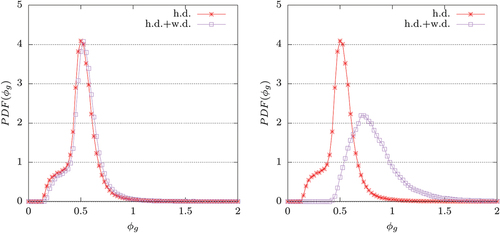
The mixture inhomogeneity within the flame has implications on the mode of combustion, which can be characterized in terms of the flame index proposed by Yamashita, Shimada, and Takeno Citation1996):
The value of this index is bounded between and
, where a predominantly non-premixed combustion behavior is expected with a negative value, while the flame is predominantly premixed with a positive value. In , the distribution of the combustion mode within
and the heat release contributions from different modes of combustion are presented.
Figure 14. Percentage of heat release nature HR (left side) and combustion mode
FI in the region given by
(right side) for all spray combustion cases, at
. The L indicates laminar conditions.
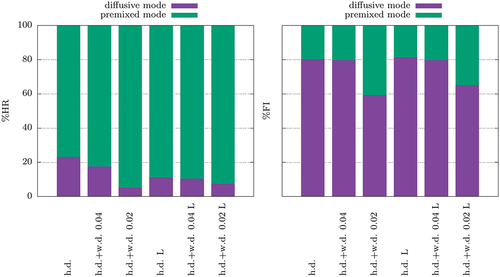
It is possible to observe the increased premixed nature of the flame with water injection. Moreover, the flame becomes increasingly premixed as the water evaporation becomes more efficient. In , it is interesting to note that the heat release is predominantly due to premixed combustion, while the non-premixed mode combustion mainly characterizes the structure of the entire flame (including the preheating and heat release zone). The behavior of the distribution has been explained by the cooling effect of the water on the temperature field, which has a direct influence on the flow velocity field. The latter affects the mixing and residence time of the droplets inside the different regions of the flame as stated earlier. Accordingly, the mixing rate is less intense with water injection. This promotes regions of high fuel concentration in the proximity of the n-heptane droplets while they are evaporating. The attenuated thermal expansion is likely to be the reason for the fuel-richer conditions, on average, with water injection. The flame thickening also causes an increase in the evaporation of the droplets within the flame in addition to the effects induced by flow velocity reduction. In a thicker flame, the droplets need more time to reach the high-temperature zone. All these phenomena related to the decrease of temperature act in the sense of stretching the space of fuel droplet evaporation which results in increased mixture inhomogeneity. While this is consistent with the widening of the probability density function of
, it cannot explain the trend of the flame index analysis, i.e. the increase of premixed combustion mode with water injection and decreasing initial diameter of the water droplets. The decrease of the water droplet diameter makes the effect of water evaporation on the flame more homogeneous. Furthermore, due to lower flame temperature, thus lower reactivity, the width of the mixing-dominated region of the flame (closer to the unburned side) relatively increases compared to the reaction-dominated region of the flame (closer to the burned side). Consequently, the time for mixing increases and the reaction-dominated region of the flame occurs under a more uniform mixture. These two effects might explain why the flame becomes more premixed with water injection and why this tendency strengthens with smaller droplets.
show the mean fuel and water droplet residence times within the flame for the different spray combustion cases. Due to turbulent velocity fluctuations, the absolute droplet velocities, on average, are higher in the turbulent cases than in the corresponding laminar cases. Moreover, the difference between the flame brush thickness and flame thickness
is obviously more significant with turbulence. In this context, the flame brush thickness is defined as:
Table 3. Flame thickness , flame brush thickness
and fuel droplet mean residence time
(where
stands for
or
depending on whether the flame thickness or flame brush thickness is considered).
stands for the averaged velocity of the fuel droplets within the flame
or within the flame brush
. The statistics are taken for all the spray combustion cases at
. The L stands for laminar and in this case
indicates the unstretched stoichiometric premixed flame thickness.
Table 4. Flame thickness , flame brush thickness
and water droplet mean residence time
(where
stands for
or
depending on whether the flame thickness or flame brush thickness is considered).
stands for the averaged velocity of the water droplets within the flame
or within the flame brush
. The statistics are taken for all the spray combustion cases at
. The L stands for laminar and in this case
indicates the unstretched stoichiometric premixed flame thickness.
where the operator indicates spatial averaging of
in both homogeneous directions
. In the turbulent cases, the definition of the mean droplet residence time within the flame is less straightforward, because the droplets do not follow a straight trajectory through the flame. Using the flame brush thickness considers the active region of the turbulent flame in the physical space.
As demonstrated by the , the droplets consistently show a higher residence time with water injection. The reasons for this, i.e. flame thickening and attenuated thermal expansion, have been discussed earlier and the consequences on the flame structure are discussed in the following.
The flame index distribution in shows a predominantly non-premixed combustion mode in the first quarter and then the flame becomes predominantly premixed. In this first part, the dominant phenomenon is the droplet evaporation, generating many high fuel concentration spots. Thereafter, the mixing becomes dominant and redistributes the evaporated fuel. In the last part, where the reactivity becomes dominant, the heat release is mainly due to premixed combustion and only a small percentage is due to non-premixed mode of combustion. Note that the heat release rate peaks at for the present thermo-chemistry. In , the cases with water injection show a stronger non-premixed mode than the cases without water in the first half of the flame, whereas from
, there is an inversion and the cases with water injection tend to exhibit more premixed mode of combustion than the cases without water. This tendency is getting stronger when the initial diameter of the water droplets decreases. As previously mentioned, the flow is dominated by evaporation and mixing in the first part of the flame. The turbulent transport is less intense with water injection and so the mixing is less effective. However, due to the flame thickening and lower thermal expansion, the space and the time for mixing increase, leading to enhanced homogeneity towards the burned gas side of the flame.
Conclusions
The carrier-phase DNS conducted in this work are based on a hybrid Eulerian-Lagrangian-Lagrangian approach with two-way coupling between the gaseous phase and different kinds of liquid phases, i.e. evaporating fuel droplets and water droplets. It is shown that premixed flames and spray flames respond differently under the influence of water injection despite having the same overall equivalence ratio. The main conclusions of the present work are:
• The discrepancies between gaseous premixed and spray flames are mainly due to the difference in the gaseous equivalence ratio, which remains lower in spray combustion cases in comparison to the overall equivalence ratio. In the simulations considered here, where a stoichiometric overall equivalence ratio is imposed, the combustion in spray flames occurs under predominantly fuel-lean conditions, hence the flame temperature is lower than for gaseous premixed cases. Since the flame temperature directly affects the flame thickness and the strength of thermal expansion, it also affects the residence time of the droplets inside the flame and increases the consequences associated with them. Accordingly, the water droplets alter the burning velocity and mean flow velocity via the cooling effect on gas temperature. In summary, the differences in droplet residence time and flame structure make the spray combustion more sensitive to the variation of initial water droplet diameters.
• In terms of the flame morphology, the consequences of water droplets are mainly reflected by the temperature field, whereas the n-heptane droplets deform both the temperature and progress variable fields.
• The net effect of water injection is a partial shift from non-premixed to premixed mode. At the same time, the spray combustion occurs under relatively fuel-richer conditions with water injection and these trends appear consistently in laminar and turbulent flows. Both observations are a consequence of the flame cooling which also affects the mixing characteristics within the flame. Both the mixing- and reaction-dominated region of the flame are stretched as a result of the flame thickening.
This work initiates potential future investigations on spray combustion with water injection. For example, one may consider a broader range of important parameters, like initial droplet diameter, overall water loading and overall equivalence ratio to evaluate the consequences of water injection as a means of manipulating the combustion process. Finally, it will be worthwhile to validate the findings of the current analysis in the presence of a detailed chemical mechanism to investigate the effectiveness of water injection on pollutant emission reduction in terms of quantitative predictions.
Acknowledgements
This research, in the frame of project MORE, is funded by dtec.bw – Digitalization and Technology Research Center of the Bundeswehr which we gratefully acknowledge. dtec.bw is funded by the European Union – NextGenerationEU. NC gratefully acknowledges the support from EPSRC (EP/R029369/1,EP/S025154/1).
Disclosure statement
No potential conflict of interest was reported by the author(s).
Additional information
Funding
References
- Arabaci, E., Y. İçingür, H. Solmaz, A. Uyumaz, and E. Yilmaz. 2015. Energy conversion and management 98: 89–97.
- Arias, P. G., H. G. Im, P. Narayanan, and A. Trouvé. 2011. A computational study of non-premixed flame extinction by water spray Proceedings of the Combustion Institute 33(2): 2591–97.
- Batchelor, G., and A. Townsend. 1948. Decay of turbulence in final period. Proceedings of Royal Society. A194, pp. 527–543.
- Bibrzycki J., and T. Poinsot. 2010. Reduced chemical kinetic mechanisms for methane combustion in O2/N2 and O2/CO2 atmosphere, working note ECCOMET WN. Tech. rep. CFD/10/17, CERFACS.
- Chakraborty, N., C. Kasten, U. Ahmed, and M. Klein. 2021. Evolutions of strain rate and dissipation rate of kinetic energy in turbulent premixed flames. Phys. Fluids 33 (12):125132. doi:10.1063/5.0076373.
- Chen, J. H., A. Choudhary, B. de Supinski, M. DeVries, E. R. Hawkes, S. Klasky, W. K. Liao, K. L. Ma, J. Mellor-Crummey, N. Podhorszki, R. Sankaran, S. Shende and C. S. Yoo. 2009. Terascale direct numerical simulations of turbulent combustion using S3D. Comput. Sci. Discovery. 2(1):2.1. doi:10.1088/1749-4699/2/1/015001.
- Fernández-Tarrazo, E., A. Sanchez, A. Linan, and F. Williams. 2006. A simple one-step chemistry model for partially premixed hydrocarbon combustion. Combust. Flame 147 (1–2):32–38. doi:10.1016/j.combustflame.2006.08.001.
- Fujita, A., H. Watanabe, R. Kurose, and S. Komori. 2013. Two-dimensional direct numerical simulation of spray flames-part 1: Effects of equivalence ratio, fuel droplet size and radiation, and validity of flamelet model. Fuel 104:515–25. doi:10.1016/j.fuel.2012.08.044.
- Hasslberger, J., G. Ozel-Erol, N. Chakraborty, M. Klein, and R. S. Cant. 2021. Physical effects of water droplets interacting with turbulent premixed flames: A direct numerical simulation analysis. Combust. Flame 229:229. doi:10.1016/j.combustflame.2021.111404.
- Hayashi, S., S. Kumagai, and T. Sakai. 1977. Propagation velocity and structure of flames in droplet-vapor-air mixtures. Combust. Sci. Technol 15 (5–6):169–77. doi:10.1080/00102207708946782.
- Jenkins K. W., and R. S. Cant. 2002. Curvature effects on flame kernels in a turbulent environment. Proceedings of the Combustion Institute 29(2): 2023–29.
- Keil, F. B., M. Amzehnhoff, U. Ahmed, N. Chakraborty, and M. Klein. 2021. Comparison of flame propagation statistics extracted from direct numerical simulation based on simple and detailed chemistry—part 1: Fundamental flame turbulence interaction. Energies 14 (17):5548. doi:10.3390/en14175548.
- Klein, M., A. Herbert, H. Kosaka, B. Böhm, A. Dreizler, N. Chakraborty, V. Papapostolou, H. G. Im, and J. Hasslberger. 2020. Evaluation of flame area based on detailed chemistry DNS of premixed turbulent hydrogen-air flames in different regimes of combustion. Flow Turbul. Combust 104 (2–3):403–19. doi:10.1007/s10494-019-00068-2.
- Kotob, M. R., T. Lu, and S. S. Wahid. 2020. Experimental study of direct water injection effect on NOx reduction from the gas fuel. J. Adv. Res. Fluid Mech. Therm. Sci. 76 (3):92–108. doi:10.37934/arfmts.76.3.92108.
- Lawes, M., and A. Saat 2011. Burning rates of turbulent iso-octane aerosol mixtures in spherical flame explosions 33(2):2047–54.
- Lellek, S. E. M. 2017. Pollutant Formation in Premixed Natural Gas SwirlFlames with Water Injection. PhD thesis. Technische Universität München.
- Malkeson, S. P. D. H. Wacks, and N. Chakraborty. 2020. Statistical behaviour and modelling of fuel mass fraction dissipation rate transport in turbulent flame-droplet interaction: A direct numerical simulation study. Flow Turbul. Combust 105 (1):237–66. doi:10.1007/s10494-019-00083-3.
- Merola, S. S., A. Irimescu, and B. M. Maria Vaglieco. 2020. Influence of water injection on combustion identified through spectroscopy in an optical direct injection spark ignition engine. Fuel 273:273. doi:10.1016/j.fuel.2020.117729.
- Mingrui, W., N. Thanh Sa, R. F. Turkson, L. Jinping, and G. Guanlun. 2017. Water injection for higher engine performance and lower emissions. J. Energy Inst 90 (2):285–99. doi:10.1016/j.joei.2015.12.003.
- Neophytou, A., and E. Mastorakos. 2009. Simulations of laminar flame propagation in droplet mists. Combust. Flame 156 (8):1627–40. doi:10.1016/j.combustflame.2009.02.014.
- Neophytou, A. E. Mastorakos, and R. S. Cant. 2010. DNS of spark ignition and edge flame propagation in turbulent droplet-laden mixing layers. Combust. Flame 157 (6):1071–86. doi:10.1016/j.combustflame.2010.01.019.
- Neophytou, A., E. Mastorakos, and R. S. Cant. 2012. The internal structure of igniting turbulent sprays as revealed by complex chemistry DNS. Combust. Flame 159 (2):641–64. doi:10.1016/j.combustflame.2011.08.024.
- Nicoli, C., B. Denet, and P. Haldenwang. 2014. Lean flame dynamics through a 2D lattice of alkane droplets in air. Combust. Sci. Technol 186 (2):103–19. doi:10.1080/00102202.2013.847930.
- Nicoli, C., P. Haldenwang, and B. Denet. 2016. Spray-flame dynamics in a rich droplet array. Flow Turbul. Combust 96 (2):377–89. doi:10.1007/s10494-015-9675-4.
- Nicoli, C., P. Haldenwang, and B. Denet. 2019. Premixed flame dynamics in presence of mist. Combust. Sci. Technol 191 (2):197–207. doi:10.1080/00102202.2018.1453728.
- Ozel-Erol, G., J. Hasslberger M. Klein, and N. Chakraborty. 2019. A direct numerical simulation investigation of spherically expanding flames propagating in fuel droplet-mists for different droplet diameters and overall equivalence ratios. Combust. Sci. Technol 191 (5–6):833–67. doi:10.1080/00102202.2019.1576649.
- Pera, C., S. Chevillard, and J. Reveillon. 2013. Effects of residual burnt gas heterogeneity on early flame propagation and on cyclic variability in spark-ignited engines. Combust. Flame 160 (6):1020–32. doi:10.1016/j.combustflame.2013.01.009.
- Reveillon, J., and L. Vervisch. 2005. Analysis of weakly turbulent dilute-spray flames and spray combustion regimes. J Fluid Mech 537 (–1):317–47. doi:10.1017/S0022112005005227.
- Schroll P., A. P. Wandel, R. S. Cant and E. Mastorakos. 2009. Direct numerical simulations of autoignition in turbulent two- phase flows. Proceedings of the Combustion Institute 32(2):2275–82.
- Shahpouri, S., and E. Houshfar. 2019. Nitrogen oxides reduction and performance enhancement of combustor with direct water injection and humidification of inlet air. Clean Technol. Environ. Policy 21 (3):667–83. doi:10.1007/s10098-019-01666-4.
- Sreedhara, S., and K. Y. Huh. 2007. Conditional statistics of nonreacting and reacting sprays in turbulent flows by direct numerical simulation. Proceedings of the Combustion Institute 31(2):2335–42.
- Sun, X., J. Ning, X. Liang, G. Jing, Y. Chen, and G. Chen. 2022. Effect of direct water injection on combustion and emissions characteristics of marine diesel engines. Fuel 309:309. doi:10.1016/j.fuel.2021.122213.
- Takasaki, K., T. Fukuyoshi, and S. Abe. 1998. Improvement of diesel combustion with stratified fuel/water injection system. In: Proceedings of the 4th C OMODIA Fukuoka, Japan, pp. 57–62.
- Tesfa, B., R. Mishra, F. Gu, and A. D. Ball. 2012. Water injection effects on the performance and emission characteristics of a CI engine operating with biodiesel. Renewable Energy 37 (1):333–44. doi:10.1016/j.renene.2011.06.035.
- Thomas, G. O., A. Jones, and M. J. Edwards. 1991. Influence of water sprays on explosion development in fuel-air mixtures. Combust. Sci. Technol 80 (1–3):47–61. doi:10.1080/00102209108951776.
- Turquand, C., V. Papapostolou, S. F. Ahmed, and N. Chakraborty. 2019. On the minimum ignition energy and its transition in the localised forced ignition of turbulent homogeneous mixtures. Combust. Flame 201:104–17. doi:10.1016/j.combustflame.2018.12.015.
- Wacks, D. H., N. Chakraborty, and E. Mastorakos. 2016. Statistical analysis of turbulent flame- droplet interaction: A direct numerical simulation study. Flow Turbul. Combust 96 (2):573–607. doi:10.1007/s10494-015-9652-y.
- Wandel, A. P., N. Chakraborty and E. Mastorakos. 2009. Direct numerical simulations of turbulent flame expansion in fine sprays. Proceedings of the Combustion Institute 32(2):2283–90.
- Wang, Y., and C. J. Rutland 2005. Effects of temperature and equivalence ratio on the ignition of n-heptane fuel spray in turbulent flow. Proceedings of the Combustion Institute 30(1):893–900.
- Wray, A. A. 1990. Minimal storage time advancement schemes for spectral methods. In: NASA Ames Research Center, California, Report No. MS202.
- Yamashita, H., M. Shimada, and T. Takeno 1996. Symposium (International) on Combustion 26:27–34.
- Zeuch, T., G. Moréac, S. S. Ahmed, and F. Mauss. 2008. A comprehensive skeletal mechanism for the oxidation of n-heptane generated by chemistry-guided reduction. Combust. Flame 155 (4):651–74. doi:10.1016/j.combustflame.2008.05.007.
- Zhang, P., Y. Zhou, X. Cao, X. Gao, and M. Bi. 2014. Mitigation of methane/air explosion in a closed vessel by ultrafine water fog. Saf Sci 62:1–7. doi:10.1016/j.ssci.2013.07.027.

